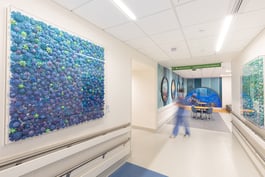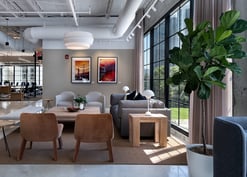Architecture and design are undergoing a rapid transformation. At the recent AIA Conference on Architecture, one clear message emerged: the future of the built environment is rooted in integration, driven by data, shaped by sustainability, and centered on human well-being.
Design professionals are leveraging emerging technologies to better understand how people experience space. At the same time, they are embracing environmental responsibility as a core design principle. When innovation, stewardship, and empathy are brought together, the result is smarter, more resilient, and more meaningful places.
The AI Revolution: Augmenting Design, Not Replacing It
Artificial intelligence was once met with hesitation in the design world, but that conversation has shifted. At AIA 2025, leaders recognized AI as a strategic advantage rather than a threat. The focus is no longer on whether to adopt it, but how to implement it thoughtfully.
AI is not replacing the architect. Instead, it is helping designers work more efficiently and creatively. By handling complex calculations and repetitive tasks, AI allows teams to spend more time on design thinking, collaboration, and innovation. The expanding ecosystem of architectural software points toward a future where technology supports and elevates human insight.

Data-Informed Design: Quantifying the Human Experience
Modern technology is transforming design into a data-informed discipline, offering new ways to gather and analyze information about how people experience the built environment. This shift allows architects to ground their decisions in empirical evidence, enabling them to test, validate, and refine their designs based on real-world performance.
At the AIA Conference, the Human Architecture & Planning Institute and iMotions booths showcased how biometric tools are advancing human-centric design. Technologies like eye-tracking goggles, which record where people look first in a space, and facial expression analysis software provide objective insights into user experience. By measuring neurophysiological responses to elements such as light, color, and spatial layout, architects can better understand how design affects cognitive function and emotional well-being. These insights are helping teams enhance wayfinding and create spaces that are not only visually compelling but also demonstrably supportive of health and wellness (Abbas et al., 2024).
Sustainability as Stewardship: A Core Responsibility
Sustainable design emerged as a central theme throughout the conference, not as a passing trend, but as a professional obligation. Sustainability is now viewed as an essential component of the design process, shaping not only how buildings are constructed and operated but also how they serve the people and communities they impact.
In the session “Design Intelligence for Architects,” Miles Smith and Marton Kiss of Graphisoft emphasized that construction activity contributes significantly to global carbon emissions, but the conversation around sustainability went beyond emissions. It centered on the broader role of architects as stewards of both the environment and society.
Future-forward sustainable design considers environmental impact through thoughtful material choices, energy-efficient systems, and circular design strategies. At the same time, it recognizes the social dimension of sustainability. This includes designing spaces that promote equity, health, and well-being; ensuring access to green spaces; improving indoor air quality; and creating buildings that respond to the needs of underserved communities.
Resilience and adaptability are also key. As climate risks increase and societal needs evolve, architects are challenged to design spaces that not only reduce harm but actively contribute to community strength and cohesion. Sustainability, in this sense, is about creating architecture that supports people and the planet now and for generations to come.

The Built Environment's Impact on Wellbeing
Advancements in AI, data collection, and sustainable design are supporting a shift toward human-centric spaces that prioritize well-being. This focus was woven throughout the AIA Conference, highlighting a growing recognition that the built environment plays a direct role in shaping health, productivity, and community outcomes.
In the session “Healthcare Work Environments & Employee Well-being: A Pilot Study,” Cedra Goldman explored how restorative design can help reduce stress and mediate burnout, especially in high-pressure settings like hospitals and workplaces. This presentation detailed a pilot study that used early-stage biometric and qualitative data to examine how architectural features such as lighting, acoustics, and access to nature influence emotional and physical well-being. While still in its early phases, the research provides an important foundation for understanding how intentional design choices can support staff resilience and performance.
Biophilic design was a key part of this conversation, backed by compelling neuroscience. In addition to the formal sessions, several booth exhibitors, including Green Plants for Green Buildings, hosted talks on how incorporating living plants and natural elements into buildings can measurably reduce stress and improve cognitive function. These presentations translated complex research into accessible insights, showing how nature-based design choices can lower heart rates, boost mood, and enhance focus. The message was clear: designing with nature is not just visually appealing, but scientifically beneficial.
Together, these insights signal a future where buildings are not only sustainable and efficient but also restorative and deeply attuned to the needs of the people who occupy them.

The Human-Centric Blueprint
When thoughtful design, technology, and sustainable principles come together, the result is architecture that is both responsive and attuned to the human experience. AIA 2024 made clear that the future of design lies in creating environments that actively support well-being and take a holistic view of a space’s impact: physically, emotionally, and socially. By embracing innovation, prioritizing sustainability, and centering user experience, architects and designers are shaping spaces that are not only functional and modern but also meaningful and inspiring.
How TurningArt Supports This Vision
At TurningArt, we believe that art is an essential part of this human-centric approach. As more architects and designers embrace strategies that prioritize the user experience, art is increasingly recognized as a powerful tool for enhancing well-being, building community, and reinforcing a sense of identity and place.
Our rotating art programs, commissioned installations, and data-informed curations are designed to integrate seamlessly into public, commercial, healthcare, and institutional environments. By collaborating closely with design teams, we ensure that the artwork reflects the goals of each space, contributing to environments that feel connected, restorative, and thoughtfully considered.

Connect with an Art Advisor below to learn more!

.jpg?width=332&height=177&name=_MG_0840%20copy%20(2).jpg)

.jpg?width=332&height=177&name=dtBv_067_DSC_2139_DaNil%20(2).jpg)



